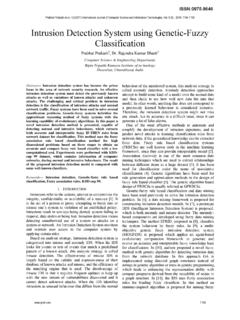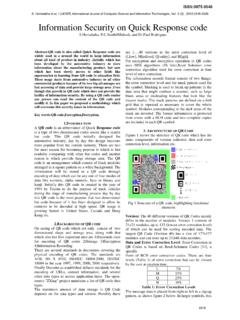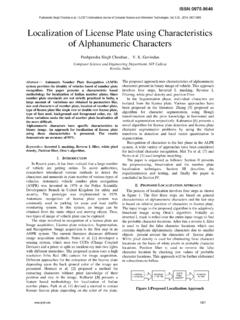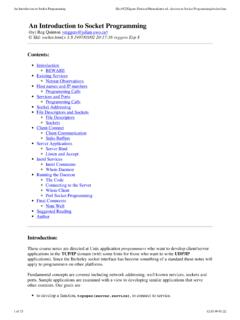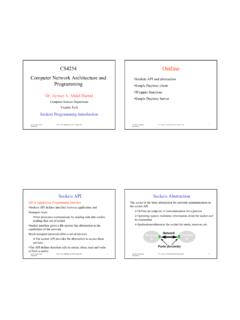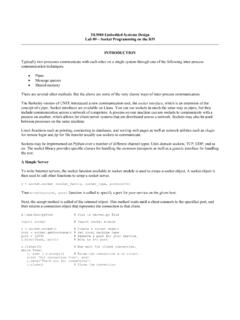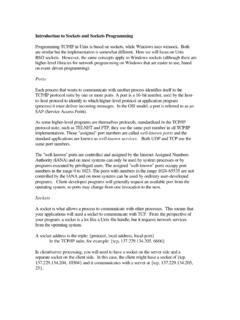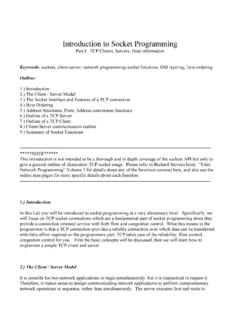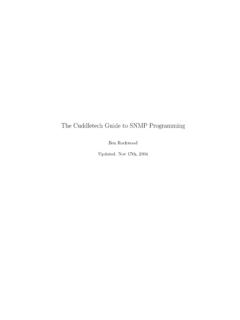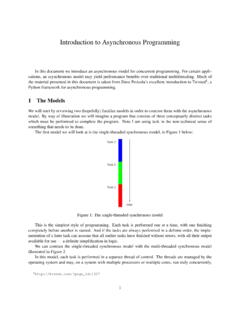Transcription of 462. Socket programming by Limi Kalita - IJCSIT
1 Socket programming Limi Kalita Student, Department of Computer Science and Engineering, Assam Down Town University, Guwahati, India. Abstract: The aim of the paper is to introduce sockets , its deployment pertaining to network programming . sockets play a vital role in client server applications. The client and server can communicate with each other by writing to or reading from these sockets . They were invented in Berkeley as part of the BSD flavor of UNIX operating systems. And they spread like wildfire with the Internet. This paper introduces elements of network programming and concepts involved in creating network applications using sockets . One of the most basic network programming tasks likely to be faced as a java programmer is performing the Socket functions/methods because java has been preferred mostly for establishing client server communications using sockets .
2 Keywords: Socket , Port, Transport Layer, TCP, UDP 1. INTRODUCTION: In the 1980s, the US government s Advanced Research Projects Agency (ARPA) provided funds to the University of California at Berkeley to implement TCP/IP protocols under the UNIX operating system. During this project, a group of Berkeley researchers developed an application program interface (API) for TCP/IP network communications called the Socket interface. The Socket interface is an API TCP/IP networks it defines a variety of software functions or routines for the development of applications for TCP/IP networks. The Socket interface designers originally built their interface into the UNIX operating system.
3 However, the other operating systems, environments, such as Microsoft Windows, implement the Socket interface as software libraries. However, regardless of the environment in which we program, the program code will look much the same. Socket programming can be done in any language, which supports network communication, but java is preferred because it is platform independent, it has exception mechanisms for robust handling of common problems that occur during I/O and networking operations and its threading facilities provide a way to easily implement powerful servers One of java s major strong suits as a programming language for client-server application development is its wide range of network support.
4 Java has this advantage because it was developed with the Internet in mind. Another advantage of java is that it provides security. The result is that we have a lot of options in regard to network programming in Java. Java performs all of its network communication through sockets . Client-Server Communication A network is composed of computers which is either a client or a server. A server is a program that is offering some service whereas a client is a program that is requesting some service. Servers are powerful computers or processes dedicated to managing disk drives (file servers), printers (print servers), or network traffic (network services) whereas clients are PCs or workstations on which users run applications.
5 Clients rely on servers for resources, such as files, devices and even processing power. When these programs are executed, as a result, a client and a server process are created simultaneously and these two processes communicate with each other by reading from and writing to sockets as shown in figure: Client Server Limi Kalita / ( IJCSIT ) International Journal of Computer Science and Information Technologies, Vol. 5 (3) , 2014, sockets are the programming interfaces provided by the TCP and UDP protocols for stream and datagram communication respectively of the transport layer which is a part of the TCP/IP stack. When creating a network application, the developer's main task is to write the code for both the client and server programs.
6 The client/server application that is covered here is a proprietary client/server application. A single developer (or development team) creates both the client and server programs, and the developer has complete control over what goes in the code. But because the code does not implement a public-domain protocol, other independent developers will not be able to develop code that interoperates with the application. When developing a proprietary application, the developer must be careful not to use one of the well-known port numbers defined in the RFCs. sockets : This term Socket has come from an electricity/phone Socket metaphor where sockets acts as interfaces that plug into each other over a network.
7 Technically, sockets had been defined in many ways. 1. According to Wikipedia, a network Socket is an endpoint of an inter-process communication flow across a computer network . A Socket is composed of an IP address and a port number. 2. sockets can be defined as the end-points of a connection between two computers identified by an IP Address and a port number. 3. sockets can also be defined as a software abstraction used to represent the terminals of a connection between two machines. 4. It can also be defined as an abstraction that is provided to an application programmer to send or receive data to another process. 5. The Socket is the door between the application process and TCP.
8 6. Socket is an interface between the application and the network. One popular of sockets are the Dixie cups game played where we took two paper cups and tied them together with the help of a string to form a telephone as shown in figure: Figure: Dixie cups Figure: Examples of a Socket Limi Kalita / ( IJCSIT ) International Journal of Computer Science and Information Technologies, Vol. 5 (3) , 2014, friend would take one of the cups and walk to the other side of the room and talk into the cup. You would put your ear up to the other cup and be able to hear your friend. The Dixie cups in this example represent sockets . You communicate with your friend by talking into the cup (getting an output stream from the Socket and sending bytes) and by putting your ear up to the cup to hear your friend talk (getting an input stream from the Socket and reading data from it).
9 A stream is a flowing sequence of characters that flow into or out of a process. Operations of Socket : A Socket performs four fundamental operations: 1. To connect to a remote machine, 2. Send data, 3. Receive data and 4. Close the connection. A Socket may not be connected to more than one host at a time. However, a Socket may both send data to and receive data from the host to which it's connected. The class is Java's interface to a network Socket and allows you to perform all four fundamental Socket operations. Port: In computer networking, a port is an application-specific or process-specific software construct serving as a communications endpoint in a computer's host operating system.
10 A port is associated with an IP address of the host, as well as the type of protocol used for communication. The purpose of ports is to uniquely identify different applications or processes running on a single computer. The protocols that primarily use ports are the Transport Layer protocols, such as the Transmission Control Protocol (TCP) and the User Datagram Protocol (UDP) of the Internet software stack, often called TCP/IP (Transport Control Protocol/Internet Protocol)stack, as shown in figure They use ports to map incoming data to a particular process running on a computer. So a port will identify a Socket on a host. Again, an IP Address is not enough to identify a unique server, because many server programs may exist on one machine.


